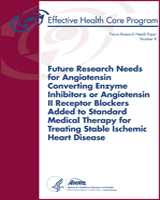Future Research Needs for Angiotensin Converting Enzyme Inhibitors or Angiotensin II Receptor Blockers Added to Standard Medical Therapy for Treating Stable Ischemic Heart Disease
Future Research Needs Papers, No. 8
Authors
Investigators: Gillian D Sanders, PhD, Benjamin Powers, MD, Matthew Crowley, MD, Evan Myers, MD, MPH, Amanda McBroom, PhD, Michael Musty, BA, and Rebecca Gray, DPhil.Affiliations
Excerpt
A comparative effectiveness review (CER) published by the University of Connecticut Evidence-based Practice Center (EPC) in 2009 found strong evidence that ACE inhibitors reduced total mortality and nonfatal myocardial infarction (MI) in comparison to placebo among adults with stable IHD and preserved ventricular function, but increased the risk for syncope and cough. There was low to moderate evidence that ARBs reduced a composite of cardiovascular endpoints compared to placebo, and these agents were well-tolerated. The one available study directly comparing the impact of ACE inhibitors and ARBs on cardiovascular outcomes in patients with IHD revealed no significant difference between the classes in the rate of cardiovascular outcomes, but demonstrated higher rates of cough and angioedema among patients treated with ACE inhibitors, and higher rates of hypotensive symptoms among patients treated with ARBs.
A list of research gaps is a common component of CERs and is an important step in outlining a future research agenda; however, such lists do not always clearly suggest how future research should be prioritized, or which projects are in fact feasible. In this pilot project, we sought to expand on the work done by the University of Connecticut EPC to identify and prioritize gaps in the evidence supporting the comparative effectiveness of ACE inhibitor and ARB therapy in patients with IHD. The prioritization process we used combined a review of recently published and ongoing studies, engagement of nine stakeholders, and participation of these stakeholders in both qualitative and quantitative exercises of research needs prioritization.
Acknowledgments: The Duke Evidence-Based Practice Center thanks investigators William Baker, PharmD, BCPS, and C Michael White, PharmD, FCP, FCCP, for valuable discussions regarding the comparative effectiveness review Comparative Effectiveness of Angiotensin Converting Enzyme Inhibitors or Angiotensin II Receptor Blockers Added to Standard Medical Therapy for Treating Stable Ischemic Heart Disease prepared by the University of Connecticut/Hartford Hospital Evidence-based Practice Center.
Stakeholder Group: Javed Butler, MD, MPH, FACC, FAHA; Emory University; Atlanta, GA
Joanne Foody, M.D., F.A.C.C., F.A.H.A.; Brigham and Women’s Hospital; Boston, MA
David Gordon, M.D., Ph.D., M.P.H.; National Heart Lung and Blood Institute; Bethesda, MD
Michael Ho, M.D., Ph.D.; Denver VA Medical Center; Denver, CO
Newell McElwee, Pharm.D., M.P.H.; Merck & Co., Inc.; North Wales, PA
Allison Rosen, M.D., M.P.H., ScD.; University of Massachusetts; Worcester, MA
Lawrence Sadwin, B.S.; Patient Advocate, Warren, RI
David Sugano, Dr.P.H.; Novartis; East Hanover, NJ
Jed Weissberg, M.D.; Kaiser Permanente; Oakland, CA
AHRQ Contacts: Carolyn M Clancy, MD, Director, Agency for Healthcare Research and Quality; Stephanie Chang, MD, MPH, Director, Evidence-based Practice Center Program, Agency for Healthcare Research and Quality; Jean Slutsky, PA, MSPH, Director, Center for Outcomes and Evidence, Agency for Healthcare Research and Quality; Elisabeth U Kato, MD, MRP, Task Order Officer, Evidence-based Practice Center Program, Agency for Healthcare Research and Quality
Prepared for: Agency for Healthcare Research and Quality, U.S. Department of Health and Human Services, Contract No. 290-2007-10066-I. Prepared by: Duke Evidence-based Practice Center, Durham, NC
Suggested citation:
Sanders GD, Powers B, Crowley M, Myers E, McBroom A, Musty M, Gray R. Future Research Needs for Angiotensin Converting Enzyme Inhibitors or Angiotensin II Receptor Blockers Added to Standard Medical Therapy for Treating Stable Ischemic Heart Disease. Future Research Needs Paper No. 8. (Prepared by Duke Evidence-based Practice Center under Contract No. 290-2007-10066-I.) AHRQ Publication No. 11-EHC006-EF. Rockville, MD: Agency for Healthcare Research and Quality. November 2010. Available at: www.effectivehealthcare.ahrq.gov/reports/final.cfm.
This report is based on research conducted by the Duke Evidence-based Practice Center (EPC) under contract to the Agency for Healthcare Research and Quality (AHRQ), Rockville, MD (Contract No. 290-2007-10066-I). The findings and conclusions in this document are those of the author(s), who are responsible for its contents; the findings and conclusions do not necessarily represent the views of AHRQ. Therefore, no statement in this report should be construed as an official position of AHRQ or of the U.S. Department of Health and Human Services.
The information in this report is intended to help health care researchers and funders of research make well-informed decisions in designing and funding research and thereby improve the quality of health care services. This report is not intended to be a substitute for the application of scientific judgment. Anyone who makes decisions concerning the provision of clinical care should consider this report in the same way as any medical research and in conjunction with all other pertinent information, i.e., in the context of available resources and circumstances.
This report may be used, in whole or in part, as the basis for research design or funding opportunity announcements. AHRQ or U.S. Department of Health and Human Services endorsement of such derivative products may not be stated or implied.
This information does not represent and should not be construed to represent a determination or policy of the Agency for Healthcare Research and Quality or the U.S. Department of Health and Human Services.
None of the investigators has any affiliations or financial involvement that conflicts with the material presented in this report.
- 1
540 Gaither Road, Rockville, MD 20850;www
.ahrq.gov
